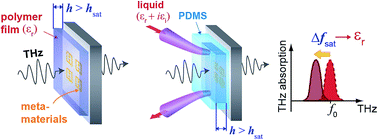Dielectric constant measurements of thin films and liquids using terahertz metamaterials†
Abstract
In this paper, we demonstrate that terahertz (THz) metamaterials are powerful tools for determination of dielectric constants of polymer films and polar liquids. As we deposit a dielectric film on a metamaterial, the resonant frequency shifts, but saturates at a specific thickness due to the limited sensing volume of the metamaterial. From the saturated value, we can extract the dielectric constants of various polymers that are transparent to the THz frequency range. In addition, we fabricated a microfluidic channel that contains the metamaterials to address the real dielectric constants for a polar liquid solution. This was possible due to an extremely confined electric field near the gap area of the metamaterials, enabling us to employ very thin liquid layers. We found that the resonance shifts do not depend critically on the imaginary dielectric constants, proving that our approach can be universal in terms of various materials, including absorptive materials. As an example, the dielectric constants of sodium chloride and potassium chloride solutions have been determined with various concentrations. Our experimental findings were successfully confirmed by finite-difference time-domain simulations.


 Please wait while we load your content...
Please wait while we load your content...